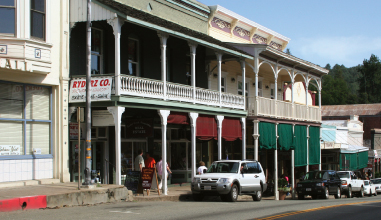Amador County, in the heart of the Gold Country foothills along the western flank of the Sierras, is attracting a new type of fortune seeker these days, one whose treasure comes from a barrel and not a mine shaft. The wine lover.
Amador’s burgeoning wine industry is attracting international notice, with vintages gathering up acclaim from critics and medals in wine competitions. So far, though, Amador has remained true to its rural roots. The atmosphere is low-key and unpretentious. Napa it’s not—which can be a good thing. Most wineries are family-run, with the owners tending vineyards or pouring in tasting rooms. Tasting fees are nowhere to be found, and people with all levels of wine knowledge are welcome.
About two highway hours southeast of Marin, Amador makes for a perfect weekend getaway. The local vintners’ association lists more than two dozen wineries on its map, so when my husband, Matt, and I set out we knew it would be easy to find worthwhile places to visit. Accordingly, we abandoned our usual specific itinerary-making in favor of a more relaxed, adventurous approach.
Our first stop was the Amador Vintage Market in tiny Plymouth, where we picked up sandwiches (curried chicken salad and barbecue tri-tip) and roasted veggies for lunch, along with some winery advice. Story Winery was the clear favorite for a picnic spot. There we ate beneath shady trees and enjoyed a sweeping view of the Cosumnes River canyon.
Inside, in Story’s unassuming tasting room—a small wooden house that was the property’s original homestead—we sniffed, swirled and sipped our way through the winery’s collection of Zinfandels. Though we’d hardly call ourselves wine experts, it was interesting to taste the differences between vintages and between grapes grown in different parts of the vineyard. A sample of Zinfandel port and dark chocolate capped off the visit.
 Leisurely meandering the country back roads, we came upon Wilderotter Winery, whose Tuscan-inspired tasting room drew us in. We knew it was a good stop as soon as we tasted the first two wines on the extensive list—a Viognier, followed by a Grenache rosé. Naomi Aradi, the wine club and events manager, touted the foothills’ growing allure as she poured—“people are realizing that Napa isn’t the only wine area”—noting that it’s not uncommon for employees of Napa wineries to visit Amador wineries on their days off.
Leisurely meandering the country back roads, we came upon Wilderotter Winery, whose Tuscan-inspired tasting room drew us in. We knew it was a good stop as soon as we tasted the first two wines on the extensive list—a Viognier, followed by a Grenache rosé. Naomi Aradi, the wine club and events manager, touted the foothills’ growing allure as she poured—“people are realizing that Napa isn’t the only wine area”—noting that it’s not uncommon for employees of Napa wineries to visit Amador wineries on their days off.
Out destination for the night was the Foxes Inn, a sumptuous bed-and-breakfast in downtown Sutter Creek, where our room had vaulted ceilings, antique furnishings and a slate-tiled bath. After a game of checkers on the front porch, we stepped back in time to wander Sutter Creek’s six-block Main Street. Covered sidewalks and balconies lend a nostalgic feel, as do myriad antiques stores and specialty shops like the Music Box, which originally opened in Tiburon in 1989. Down the street at the Sutter Creek Ice Cream Emporium, rows of candy and cookies line the shelves and the shop’s owner plays ragtime on the upright piano. No chain stores exist downtown, and pedestrians almost outnumber the passing cars.
Eager to try more foothill wine, we ducked into Susan’s Place Wine Bar & Eatery just off Main Street and found a table in the arbor-shaded courtyard. We each ordered a blind tasting flight of three, then laughed when we could only correctly identify two out of the six wines, despite all the assiduous sampling of that afternoon’s discoveries. We finished the evening with dinner at the stylishly sleek Caffè Via d’Oro.
The next morning after a breakfast, which was served outside in the gazebo—I opted for sourdough French toast—we headed back to Amador’s main wine-producing area, the Shenandoah Valley, for more tasting and a dose of history. The county’s signature wine, Zinfandel, is believed to have been cultivated in Amador since at least 1868; some say miners from Eastern Europe were the first to bring it over. The grape thrived in the area’s dry, hot summer climate and has become a standard at most wineries in the region.
Sobon Estates, our next stop, specializes in Zinfandel, particularly old vine Zins. The original winery on the site was founded in 1856, yet Sobon is thoroughly modern in its farming approach—its vineyards are organic. At Shenandoah Vineyards we were poured the only Cabernet Sauvignon we would try that weekend (the area is generally too warm for the grape), and at Vino Noceto we sampled Sangiovese in the tasting “barn.” This place had more visitors than we’d encountered thus far, though the crowd seemed smaller than it actually was thanks to the quick pours, the open barn doors and the bocce court outside.
Villa Toscana, our last stop, was more estate-like than the others we’d visited, complete with fountain, picnic areas and a deli. The spacious tasting room had a long bar at the back, and straight-from-the-barrel tastings were poured in one corner.
As we headed home, I knew we could have stayed longer. But I also knew we’d be back and that until then, we’d have a little bit of Amador’s gold with us: our trunk was full of wine.


